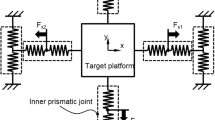Abstract
In this paper, we present a novel modeling methodology of a hexapod piezo-actuated positioning platform, which is driven by six parallel-kinematic preloaded piezo actuators. A composite electro-mechanical model, which can describe the dynamic characteristics of the power amplifier, the inverse piezoelectric effect, and the dynamics of the hexapod mechanism, is presented. The effectiveness of the proposed electro-mechanical model is demonstrated experimentally. The experimental results show that the proposed model can accurately portray the hysteresis and dynamics characteristics of the hexapod piezo-actuated positioning platform. The proposed modeling methodology can decouple the 6-DOF coupled platform, which gives a broad range of possibilities for model-based controller design on coupled piezo-actuated positioning platform.

















Similar content being viewed by others
Data Availability
All data included in this study are available upon request by contact with the corresponding author
References
Perez-Diaz, J.L., Valiente-Blanco, I., Diez-Jimenez, E., Sanchez-Garcia-Casarrubios, J.: Superconducting noncontact device for precision positioning in cryogenic environments. IEEE/ASME Trans. Mechatron. 19(2), 598–605 (2014)
Wang, F., Li, J., Liu, S., Zhao, X., Zhang, D., Tian, Y.: An improved adaptive genetic algorithm for image segmentation and vision alignment used in microelectronic bonding. IEEE/ASME Trans. Mechatron. 19(3), 916–923 (2014)
Zhou, S., Sun, J., Chen, W., et al.: Method of designing a six-axis force sensor for stiffness decoupling based on Stewart platform. Measurement 148, 106966 (2019)
Tang, H., Li, Y.M.: Feedforward nonlinear PID control of a novel micromanipulator using Preisach hysteresis compensator. Robot. Comput.-Integr. Manuf. 34, 124–132 (2015)
Yoon, J.Y., Trumper, D.L.: Friction modeling, identification, and compensation based on friction hysteresis and Dahl resonance. Mechatronics 24, 734–741 (2014)
Xie, W.F., Fu, J., Yao, H., Su, C.Y.: Observer based control of piezoelectric actuators with classical Duhem modeled hysteresis. In: American Control Conference, pp. 4221–4226 (2009)
Chen, X.K., Hisayama, T.: Adaptive sliding-mode position control for piezo-actuated. IEEE Trans. Ind. Electron. 55(11), 3927–3934 (2008)
Liaw, H.C., Shirinzadeh, B., Smith, J.: Robust neural network motion tracking control of piezoelectric actuation systems for micro/nanomanipulation. IEEE Trans. Neural Netw. 20, 356–367 (2009)
Goldfarb, M., Celanovic, N.: Modeling piezoelectric stack actuators for control of micromanipulation. IEEE Control Syst. 17, 69–79 (1997)
Juhász, L., Maas, J., Borovac, B.: Parameter identification and hysteresis compensation of embedded piezoelectric stack actuators. Mechatronics 21, 329–338 (2011)
Zhu, W., Rui, X.T.: Modeling of a three degrees of freedom piezo-actuated mechanism. Smart Mater. Struct. 26, 015006 (13 pp.) (2017)
Ismail, M., Ikhouane, F., Rodellar, J.: The hysteresis Bouc–Wen model, a survey. Arch. Comput. Methods Eng. 16, 161–188 (2009)
Shao, Z.F., Tang, X., Wang, L.P., Chen, X.: Dynamic modeling and wind vibration control of the feed support system in FAST. Nonlinear Dyn. 67, 965–985 (2011)
Staicu, S.: Dynamics of the 6-6 Stewart parallel manipulator. Robot. Comput.-Integr. Manuf. 27, 212–220 (2011)
Asadi, F., Sadati, S.H.: Full dynamic modeling of the general stewart platform manipulator via Kane’s method. Iran. J. Sci. Technol. Trans. Mech. Eng. 42, 161–168 (2018)
Han, X., Li, C., Ma, X.G.: A rigidity and flexibility coupling dynamic analysis method applied in the 6-6 Stewart parallel mechanism. Adv. Mater. Res., Trans. Tech. Publ. 694(7), 65–68 (2013)
Rui, X., Wang, G., Lu, Y., et al.: Transfer matrix method for linear multibody system. Multibody Syst. Dyn. 19, 179–207 (2008)
Rui, X., Wang, X., Zhou, Q., et al.: Transfer matrix method for multibody systems (Rui method) and its applications. Sci. China 62, 712–720 (2019)
Zhu, W., Rui, X.T.: Hysteresis modeling and displacement control of piezoelectric actuators with the frequency-dependent behavior using a generalized Bouc–Wen model. Precis. Eng. 43, 299–307 (2016)
Zhu, W., Wang, D.H.: Non-symmetrical Bouc–Wen model and corresponding parameter identification method for a piezoelectric ceramic actuator. Sens. Actuators A, Phys. 181, 51–60 (2012)
Rui, X.T., Zhang, J.S., Wang, X., Rong, B., He, B., Jin, Z.: Multibody system transfer matrix method: the past, the present, and the future. Int. J. Mech. Syst. Dyn. 2, 3–26 (2022)
Jiang, M., Rui, X.T., Zhu, W., Yang, F.F., Zhang, J.S.: Modeling and control of magnetorheological 6-DOF Stewart platform based on multibody systems transfer matrix method. Smart Mater. Struct. 29, 035029 (20 pp.) (2020)
Funding
The authors wish to acknowledge the financial support by National Natural Science Foundation of China (Grant No. 51975298), Natural Science Foundation of Jiangsu Province, China (Grant No. BK20181301), and Fundamental Research Funds for the Central Universities (Grant No. 30921011105).
Ethics declarations
Competing interests
The authors declare no competing interests.
Additional information
Publisher’s Note
Springer Nature remains neutral with regard to jurisdictional claims in published maps and institutional affiliations.
Rights and permissions
Springer Nature or its licensor (e.g. a society or other partner) holds exclusive rights to this article under a publishing agreement with the author(s) or other rightsholder(s); author self-archiving of the accepted manuscript version of this article is solely governed by the terms of such publishing agreement and applicable law.
About this article
Cite this article
Zhu, W., Jiang, M., Yang, F. et al. Modeling of a hexapod piezo-actuated positioning platform. Multibody Syst Dyn (2023). https://doi.org/10.1007/s11044-023-09917-5
Received:
Accepted:
Published:
DOI: https://doi.org/10.1007/s11044-023-09917-5




